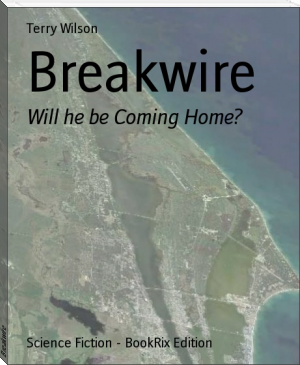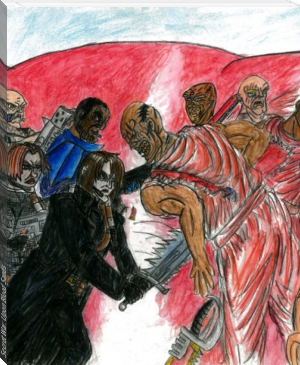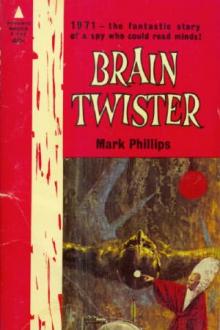Abort Abort Abort by Terry Wilson (best e reader for academics txt) 📕

- Author: Terry Wilson
Book online «Abort Abort Abort by Terry Wilson (best e reader for academics txt) 📕». Author Terry Wilson
Cover: Generated by AstroJava Ballistic Trajectory Planner at http://www.astrojava.com/btp/
Lucy and Thomas sit in the back two seats of the Sprint Crew Ferry. For this flight it was just the two of them.
In Malton Mission Control, Beatrice Laurence stands from her Flight Director’s console. She liked straight hair. Her black hair liked to grow curly, but she flatironed it out, and kept it around shoulder length. Her skin was a deep brown a bit lighter than her hair, and that typical African-American voice of hers that sounded like she always knew what she was talking about even when she didn’t have a clue, which, after three years in the Canadian Aerospace Society, wasn’t very often.
She listened to Lucy Graheme on the radio, with her distinctive Australian accent, describing the launch checklist items and readings that were coming back. Beatrice was nervous. She had only been an ascent flight director for two months. This was too normal, too perfect.
Thomas Shinra, in the left hand seat of the Sprint, where he usually sits, runs his fingers through his grey speckled dark hair on the side of his head, then returns his hands to the LCD touchscreen panel in front of him, and calls up the various windows that he’s going to want to see during the launch. His grey hairs were arriving early: he was only forty-five. Lucy had hers configured already. Lucy’s hair is drawn back into a bun and her gleaming blue eyes glance back with a worried smile. And she had her console configured too.
Beatrice watches on the big screen, the four engines under the white/silver Lilmax booster light up on her screen. She’s in Malton, while "in the next room" Ascent International controllers run the booster. They are actually located in Titusville, Florida a few miles away from the Lilmax booster and Sprint spacecraft on it, on the other side of high bandwidth internet connection and several backup connections. She watches the Lilmax single module booster leap from the pad, several big chunks of frost coming off it, the glint of the sun on the lower have which is shiny steel. She's impressed at the picture, and displays a beaming smile on her face.
The Lilmax booster actually has the same unpainted steel finish over both its liquid oxygen and kerosene fuel tanks, just that without insulation over the liquid oxygen tank, it forms white frost, which can give the illusion of paint, much as it did on the ancient Atlas and Soyuz boosters that launched the first astronauts into space in the early 1960s.
The spacecraft shakes and hums with Lucy and Thomas looking at, among other things, the receding ground behind them, billowing clouds of steam as well. Cameras on both the booster and spacecraft provide excellent views without the need for windows. Sprint has only a couple of small windows to give the crew some options if they lose electrical power and guidance computers. Windows are heavy and spacecraft designers would rather not have them at all. When it costs almost a thousand dollars a kilogram to go where you're going, weight matters. Sandy Shrinra is always reminding Thomas of that, although in her case it probably has little to do with the performance of the spacecraft. As his wife, she's concerned about different performance issues - but she does design spacecraft, the unmanned ones that will eventually accompany four selected astronauts to Mars.
As the booster ascends, Lucy and Thomas, for the most part enjoy the ride. A red number catches Thomas' eye, and there's a sudden shock in their seats, coming from the back of the spacecraft. The insistent repeating buzz of the Master Alarm starts.
In Lilmax Control in Titusville, the tiny six person crew in a control room that makes them look tiny, Communications Operator, "Comms" Nyssa Uleem, a small-eyed twenty-two year old hybrid whose international family heritage can't be guessed from her appearance, taps a switch on her console ordering a bandwidth downgrade, then priority downlink on engine number 2. She looks up at the screen, now showing a mix of yellow flame and white mist trailing behind the ascending booster and its piloted Sprint spacecraft. After a quick look at her basic status monitor, she realizes that was a mistake, and instead orders priority on the feed system data.
"Abort Abort Abort," the crisp, but calm, voice of her boss, thirty-seven year old Jack Henderson utters behind her, "Lilmax first number two LOX impeller burst. Abort Abort Abort."
In their prescribed order, the Malton Mission Control operators make their calls for a booster induced abort.
<Flight, Booster, abort has commanded auto, Mode One, over.>
<Flight, Comms, downmode two, no alarms, over.>
<Flight, Dyna, craft is stable, over.>
<Flight, Guidance, all three good, no alarms, over.>
<Flight, Bullet, no alarms, over.>
<Flight, Stove, no alarms, over.>
Beatrice slumps in her seat and rubs her eyes, they decided to pick on somebody else today. The recording loop picks up her huff, then she says, "Dyna, Flight, are we in loads or rescue?"
The answer comes fast, <Loads, Beam is nought, Stove jettison, over.> Malton Mission Control had developed a code that eliminated unnecessary syllables during Ascent and Descent phases of a Sprint flight abort, when you had to think fast and decide in seconds. The Flight Dynamics Officer, "Dyna" for short, is the guy who is responsible for figuring out, moment by moment, how, where, when, and on really bad days like this one, if the spacecraft is going to come down safely. Just three months ago, he would have said instead, "Flight, Dyna, we are in Loads. BMM is useless, recommend Service Module jettison, over."
Onboard the spacecraft, Lucy had been monitoring the kerosene tank pressure, and after the bang, noticed that it was dropping, a sure sign of a tank leak. The guidance computers had beaten her to the abort switch and fired the four rockets bolted to the spacecraft above their heads and below their feet. Thomas Shinra was busy. The shroud around the stove had come off clean, and there were no safety alarms. "Stove" was what everybody called the service module by this time, since the wok-shaped heatshield sat on it much like a frying pan on a stove, and right now, the astronauts feel like they've been stir-fried.
Lucy huffs, "This entry looks like shat-on-a-stick. Twenty gees, they put us right in the scruff bucket, probably curious how we'd shoot the beam." She's disappointed as she hears the call from Malton.
<Sprint, Malton,> starts Beatrice's crisp, smart sounding voice, <Abort abort abort. No beam, stove jettison. No beam, stove jettison. How copy? Over.> Both crew members understood every word despite the snowstorm of radio static.
"Screw that, Major," Lucy snorts, her native accent stronger than ever, "I don't want no twenty gees."
"Malton, Sprint," Thomas says slowly as he starts punching commands into his control console. "Copy all. Commander's plus-vee beam prograde, over."
Back in Mission Control, Beatrice tries not to sound too annoyed as she moans, "Really?" Her voice can only be heard within the room. In the Russian programs and the American programs, the Flight Director is in charge. Thomas Shinra's pink slip would probably be on its way out of the printer by now.
<Give my regards to Mike,> Thomas radios.
In the Canadian Aerospace Society, the crew owns the mission. Period. If Thomas wants to fire the hated backup maneuver motor to, for some bizarre reason, speed up their botched ascent, he's bloody well entitled to do just that. A movement catches her eye and she turns it to see the Dyna officer with his fist on his head. Then he reaches for his mike switch.
<Flight, Dyna. I'm so sorry,> he says as though its the end of the world, <With no damage to the ship, we can use the beam to mitigate loads, over.>
"We'll look at the windows, later," Beatrice says, "You've only been on ascent three weeks, you're doing great."
On the ship, watching the fiery view out her window and on her camera view, noticing the accelleration indicator start coming back down from sixteen and a half times Earth's gravity, she snuggles her arm deeper into into the nook on her armrest, trying to imagine what it feels like.
"How long are we going to spend in the lake?" Thomas Shinra slowly asks. "The lake" is his slang for the mighty Atlantic Ocean, what anything launched from Cape Canaveral in Florida flies over if it's trying to get into space. More often things get launched into the Atlantic Ocean: boats, submarines, cargo ships, ocean liners, and occasionally, spacecraft that aren't going into space anymore.
"Probably three days," Lucy sighs.
Thomas is happy that the parachutes and landing bags still work, and they are in the water. The two astonauts unstrap from their seats and get ready to open the hatch.
"These things keep getting better and better," Lucy says, "One of these days they're going to figure out how to drop this whole thing in the lake!"
Thomas and Lucy officially re-emerge back into the real world, the gangway has been lowered, and they emerge from the box. Inside the simulator is an actual Sprint Crew Ferry. The qualfication cabin was fitted out with a fibreglass heatshield, real propulsion system tanks and sensors, real guidance computers, and a whole bunch of extra relays to simulate failures. The propellant tanks around the cabin are filled with water, but they look, sound, and slosh much like the real ones during a simulation. They even let the water out of them as the simulated thrusters are fired. The box is suspended on half a dozen big hydraulic jacks capable of lifting and shaking the simulator, rotating it between the horizontal and the vertical position.
The simulation is scheduled for three days, and was an "end-to-ender" as they called it. The outcome of the ascent portion (except for death, obviously) was going to determine where they would go. They were now on the way to the Ocean Survival Simulator, a big indoor saltwater pool used not only by the Canadian Aerospace Society, but rented out to other space programs, armed forces, movie crews, and on occasion, kids who were planning to sail around the world solo. The building was quite a bit larger than the actual pool, since it included a big wave action generator, and wind tunnel capable of blowing up to a hundred kilometres an hour. If you were in it, you could utter a safeword and within seconds it would transform from a pitch black ten metre swell illuminated only by a couple of strobe flashes in wind that'll make you wish you could retract your head like a turtle ... to a flat calm bright as day with three paramedics descending in the overhead crane basket hoping you were okay. Today, they were going there mostly to stay in shape.
There to greet them was a blonde-haired man, a bit red in the cheeks, with shining eyes above what must have been a smiling mouth hidden by the neck ring of the orange spacesuit. From the ease by





Comments (0)